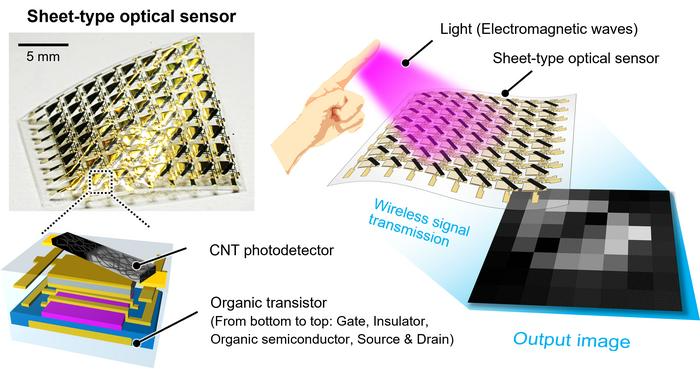Imaging technology has come a long way in the last few decades, from tiny lensless cameras that capture images with a single pixel to high-speed optical sensors that process over two million frames per second.

Sheet-type optical sensor integrated with a carbon nanotube photodetector and an organic transistor. Image Credit: Teppei Araki et al., Advanced Materials.
Researchers at Osaka University's SANKEN (The Institute of Scientific and Industrial Research) have created an optical sensor on an incredibly thin, flexible sheet that is pliable and bendable without cracking. Their work was recently published in the journal Advanced Materials. Because of its extreme flexibility, this sensor can even be rolled into a ball and still function.
Similar to the retina in the human eye, the optical sensor in a camera is the component that detects light that has gone through a lens.
Conventional optical sensors are built using inorganic semiconductors and ferroelectric materials; this makes the sensors stiff and unable to bend. To avoid this problem, we looked at a different way to detect light.
Rei Kawabata, Study Lead Author, Osaka University
The researchers utilize an array of small carbon nanotube photodetectors printed on an ultra-thin polymer substrate (less than 5 μm) instead of conventional light sensors. The carbon nanotubes heat up in response to light, producing a thermal gradient that, in turn, produces a voltage signal.
The sensitivity of the nanotubes is further increased during printing by doping them with chemical carriers. These nanotubes can be used to measure both visible and infrared light, including light associated with molecules or heat.
Organic transistors are also printed on the polymer substrate in addition to carbon nanotube sensors to arrange the voltage signals into an image signal. A computer does not need to be physically wired to the sensor to read this signal. Rather, a Bluetooth wireless module is used.
Together with this wireless system, our imager can attach soft and curved objects to analyze their surfaces or insides without damaging them.
Teppei Araki, Study Senior Author, Osaka University
The sheet-type optical sensor prototype was constructed by the researchers, who then evaluated its capacity to detect heat from wires and human fingers as well as glucose running through tubes.
They discovered that the optical sensor is highly sensitive throughout a large wavelength range. Tests conducted in an atmosphere with room temperature and pressure also revealed that it has high bending endurance and continued to function even after being crumpled.
The special benefits of this sheet-type optical sensor and wireless measurement system will open up new, easier ways to accomplish various activities, such as assessing liquid quality without taking a sample. The researchers think it has much potential for use in various fields, including wearable technology, soft robotics, and non-destructive imaging.
Journal Reference
Kawabata, R., et.al., (2024) Ultraflexible Wireless Imager Integrated with Organic Circuits for Broadband Infrared Thermal Analysis. Advanced Materials. doi.org/10.1002/adma.202309864